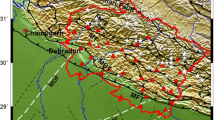Abstract
Amplification effects of soil site response can significantly impact ground motions, and must be considered in the seismic fortification of buildings/structures to prevent or mitigate this potential seismic hazard. Utilizing acceleration time histories from the main shock of the Wenchuan earthquake recorded at four stations (i.e., one on bedrock and three on soil) in the Qionghai Basin, the site responses from three soil sites are studied by using the traditional spectral ratio method. The bedrock site is selected as a reference site. This study found that peak ground accelerations (PGAs) on the soil sites are much larger than on bedrock, with EW, NS and UD components of 3.96–6.58, 6.27–10.98, and 3.17–6.66 times those of the bedrock site, respectively. The amplification effects of the soil sites on ground motions in the frequency range of 0.1 Hz to 10 Hz are significant, depending on the thickness of the soil layer and the frequency content of the site. A significant amplification occurs with high frequency components of ground motion at shallow soil sites, and low and high frequency components of ground motion at intermediate soil sites.
Similar content being viewed by others
References
Andrews DJ (1986), “Objective Determination of Source Parameters and Similarity of Earthquakes of Different Size,” Earthquake Source Mechanics, Das S, Boatwright J, and Scholz CH (eds.), American Geophysical Union, Washington D.C., 259–268.
Atkinson GM and Cassidy JF (2000), “Integrated Use of Seismograph and Strong-motion Data to Determine Soil Amplification: Response of the Fraser River Delta to the Duvall and Georgia Strait Earthquake,” Bull. Seism. Soc. Am., 90(4): 1028–1040.
Bonilla LF, Steidl JH, Lindley GT, Tumarkin AG, and Archuleta RJ (1997), “Site Amplification in the San Fernando Valley, California: Variability of Site-Effect Estimation Using the S-wave, Coda, and H/V Methods,” Bull. Seism. Soc. Am., 87(3): 710–730.
Borcherdt RD (1970), “Effects of Local Geology on Ground Motion near San Francisco Bay,” Bull. Seism. Soc. Am., 60(1): 29–61.
Field EH and Jacob KH (1995), “A Comparison and Test of Various Site-response Estimation Techniques, Including Three that Are not Reference-site Dependent,” Bull. Seism. Soc. Am., 85(4): 1127–1143.
Jiang ZX (2005), “Urgent Measures and Its Social Effect for Three Earthquakes in Ming and Qing Dynasty,” Earthquake Research in Sichuan, 2: 6–12. (in Chinese)
Lermo J and Chávez-García FJ (1993), “Site Effect Evaluation Using Spectral Ratios with Only One Station,” Bull. Seism. Soc. Am., 83(5): 1574–1594.
Malagnini L, Mayeda K, Akinci A et al. (2004), “Estimating Absolute Site Effects,” Bull. Seism. Soc. Am., 94(4): 576–590.
Tsuda K, Koketsu K, Hisada Y and Hayakawa T (2010), “Inversion Analysis of Site Responses in the Kanto Basin Using Data from a Dense Strong Motion Seismograph Array,” Bull. Seism. Soc. Am., 100(3): 1276–1287.
Wang HY (2011), “Amplification Effects of Soil Sites on Ground Motions in the Weihe Basin,” Chinese J. Geophys., 54(1): 137–150. (in Chinese)
Wen XZ and Wu DZ (1985), “Origin of the Quaternary Qionghai Basin, Xichang, Sichuan Province,” Geological Review, 31(4): 360–366. (in Chinese)
Zhang YJ, Qiao HZ, Cheng WZ et al. (2007), “Attenuation Characteristics of the Media in Sichuan Basin Region,” Journal of Seismological Research, 30(1): 43–48. (in Chinese)
Zhou XY, Wang GJ and Su JY (1991), Site, Foundation, Design Earthquake, Beijing: Earthquake Publishing House (in Chinese).
Author information
Authors and Affiliations
Corresponding author
Additional information
Supported by: International Science & Technology Cooperation Program of China under Grant No. 2011DFA71100; National Natural Science Foundation of China under Grant No. 50878199; National Basic Research Program of China under Grant No. 2007CB714201
Rights and permissions
About this article
Cite this article
Wang, H., Xie, L., Wang, S. et al. Site response in the Qionghai Basin in the Wenchuan earthquake. Earthq. Eng. Eng. Vib. 12, 195–199 (2013). https://doi.org/10.1007/s11803-013-0162-4
Received:
Accepted:
Published:
Issue Date:
DOI: https://doi.org/10.1007/s11803-013-0162-4




